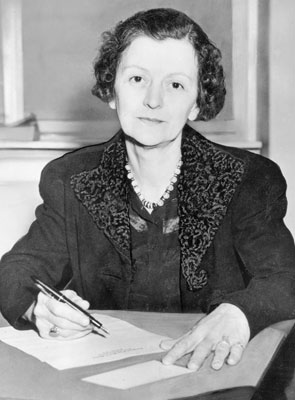Florence Reville Gibbs
Representative, 1940–1941, Democrat from Georgia
 Image Courtesy of the Office of the Clerk, U.S. House of Representatives
Image Courtesy of the Office of the Clerk, U.S. House of RepresentativesElection Day 1940 was just a month away, and the Members of the 76th Congress (1939–1941) saw no sign that they would adjourn for the election. As Members began leaving Washington to campaign, Florence Reville Gibbs arrived from Georgia, having just been elected to serve out the term of her late husband, Representative W. Ben Gibbs. Georgia’s first woman elected to Congress served three months in the U.S. House of Representatives.
Florence Reville was born in Thomson, Georgia, on April 4, 1890, the oldest child of a country doctor, Thomas Porter Reville, and Sallie Printup Reville.1 Florence Reville grew up in Thomson and left to attend Brenau College in Gainesville, Georgia. She married a lawyer, Willis Benjamin Gibbs, and the couple settled in Jesup, Georgia, and had two children.2 Ben Gibbs carved out a career as a government attorney at various local and county agencies. Eventually, he was elected unopposed to a Georgia seat in the U.S. House of Representatives for the 76th Congress. His initial term in Congress was successful enough that a district rival, John S. Gibson, informed Gibbs that he would go unchallenged at the next primary election.3 But Gibbs never stood for re-election, dying of a sudden stroke on August 7, 1940, in Washington, D.C., just 19 months into his freshman term.4
Florence Gibbs acceded to the wishes of the local Democratic county leaders, who asked her to run for her husband’s vacant seat. She won the uncontested October 1, 1940, special election called by Georgia Governor E.D. Rivers. Turnout for the special election was typically light—from the 20-county district in the state’s southeast corner, fewer than 2,500 voters went to the polls.5 The turnout was smaller than that of 1938, when her husband had first been elected to Congress unopposed with fewer than 5,000 votes. Just more than a month later, John S. Gibson was elected unopposed to the 77th Congress (1941–1943) with more than 24,000 votes.6
Florence Gibbs was sworn in two days after her election, October 3, 1940, in the midst of Franklin Roosevelt’s campaign for a third term as President, the resumption of the military draft, and the expansion of the Axis Powers into the Balkans.7 Representative Carl Vinson of Georgia, the dean of the state delegation and chairman of the Naval Affairs Committee, arranged for Gibbs to be sworn in before her certificate of election had been filed by the House.8 This was because Gibbs’s term encompassed the last three months of the 76th Congress, whose third session extended throughout 1940 and recessed only for the Democratic and Republican national conventions during the summer. The following weekend was turning into an informal recess, as Members began streaming home to campaign for re-election.9 For many Democrats, the prospects for retaining their majority status had been eroding. If Gibbs wasn’t sworn in that week, the ceremony probably would have been delayed for weeks. She never received a committee assignment. Gibbs, who had no previous professional experience, was unaccustomed to such a public position. She has been described as softspoken and unassertive. A constituent recalled, “She was good for political patronage—mainly post office appointments. The job wasn’t really to her liking.”10 Early on, Gibbs had made it clear that she would not be a candidate for re-election.11
Gibbs returned to Jesup, Georgia, at the conclusion of her House term. She died there 23 years later, on August 19, 1964.
Further Reading
“Gibbs, Florence Reville” Biographical Directory of the U.S. Congress, 1774–Present, http://bioguide.congress.gov/scripts/biodisplay.pl?index=G000155.
Footnotes
- Congressional Directory, 76th Cong., 1st sess., 1939 (Washington, D.C.: Government Printing Office, 1939): 21.
- “Rep. W.B. Gibbs, of Georgia, Dies Here After Stroke,” 8 August 1940, Washington Post: 1; “Representative Gibbs,” 9 August 1940, New York Times: 15. Both sources identify the children as Mrs. J.A. Leaphart and Warner B. Gibbs. So does the Congressional Directory from 1939.
- Congressional Record, House, 77th Cong., 1st sess. (18 June 1941): appendix 2920. Gibbs received an assignment to the Judiciary Committee.
- “Rep. W.B. Gibbs, of Georgia, Dies Here After Stroke”; “Representative Gibbs”.
- The election results are incomplete in Michael J. Dubin et al., U.S. Congressional Elections, 1788–1997 (Jefferson, NC: McFarland & Company, Inc., Publishers, 1998): 530. Dubin reports totals from just two counties. The vote figure of about 2,500 comes from Hope Chamberlin’s A Minority of Members: Women in the U.S. Congress (New York: Praeger, 1973): 156; and press reports.
- “Election Statistics, 1920 to Present,” http://clerk.house.gov/member_info/electionInfo/index.html.
- Michael Barone, Our Country: The Shaping of America From Roosevelt to Reagan (New York: Free Press, 1990): 141.
- “Mrs. Gibbs Takes Oath of Office,” 5 October 1940, Washington Post: 28.
- Robert A. Caro, The Years of Lyndon Johnson: The Path to Power (New York: Vintage, 1990): 623.
- Chamberlin, A Minority of Members: 156.
- “Takes Husband’s Place in Congress,” 6 October 1940, Washington Post: 9.

